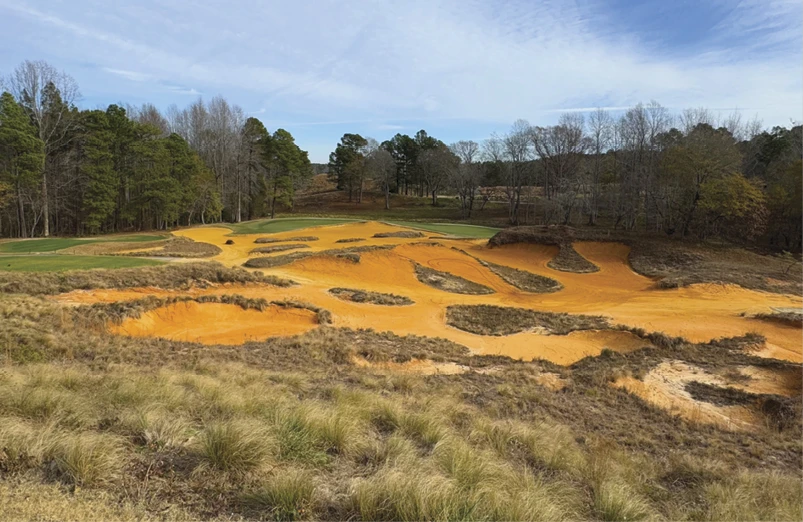
A 50-square mile arid patch between a few coastal and desert metropolises seems like an odd spot for an industry dependent on water, greenery and disposable income to be flourishing.
But unlike other golf-dense regions, Southern California’s Coachella Valley dodged the consequences of the Great Recession and finds itself in a desirable position as outsiders continue migrating to cities such as Palm Springs, La Quinta, Indian Wells, Palm Desert and Rancho Mirage. Leaders from all segments of the industry emphasized the region’s golf economic prowess during the second Coachella Valley Golf Industry Summit Jan. 16 at PGA West.
In a clubhouse dining room with elongated windows overlooking the 18th hole of the partially overseeded Palmer Private Course, PGA of America President Paul Levy, CEO and general manager of nearby Toscana Country Club, delivered a keynote address with an upbeat tenor. “I have a very bullish view on the industry of golf,” Levy says. “I have a bullish view on our people who run the clubs and a group like this.”
It’s hard not to be golf giddy when operating a facility in the Coachella Valley. For starters, the region receives more than 350 days of annual sunshine, a tremendous selling point when competing with other regions for snowbirds looking to purchase second homes with soothing views.
The sun-driven numbers are staggering. The region boasts 123 golf courses that had a $1.1 billion economic impact in 2014, according to the “Economic Impact of the Coachella Valley Golf Industry” report released in August 2015. This means a region with .8 percent of the total U.S. golf supply is responsible for 1.6 percent of the $70 billion industry. “There are very few parts of the world where you have this concentration of daily fee, resort and preeminent private clubs,” says Turf Star CEO and principal Joe Guerra, whose company served as the summit’s presenting sponsor. “You have a composite of the entire industry here.”
A young, motivated person entering the golf industry would be wise to take his or her talents to the Coachella Valley. The industry is responsible for more than 14,000 jobs in the region. Maintenance departments at elite facilities are essentially mid-sized businesses, with crew sizes exceeding 50 workers and budgets surpassing $2 million. Multiple golf management and real estate development companies are entrenched in the Coachella Valley. The volume of jobs in a condensed area makes upward mobility without uprooting possible.
“When there’s more than one club involved in a company like ours, the career opportunities are boundless,” Troon vice president of operations Bill O’Brien says. “Having been an operator for most of my career – the better part of 25 years – many of us are excited about the opportunity to advance and in a market like this there are those opportunities.”
Course closures are also rare. While building started slowing in the early 2000s, only two Coachella Valley courses have closed in the last five years. The closings are a product of land value and repurposing, according to real estate broker and golf course appraiser Z. Gordon Davidson.
O’Brien, Davidson and La Quinta Country Club COO/general manager Bruce Zahn exchanged business snapshots and ideas in a summit panel led by the GCSAA’s Jeff Jensen. The Southern California Golf Association’s Craig Kessler led the summit-ending water session which included Desert Princess Country Club superintendent Jonas Conlan, Shadow Mountain Golf Club superintendent Luke Hall and Ironwood Country Club COO/general manager Josh Tanner as panelists.
As other parts of California celebrate the end of a prolonged drought, Kessler says the Coachella Valley is different because “the desert is always in a drought.” A strong relationship between the golf industry and Coachella Valley Water Board, low water rates, a plentiful aquifer and longstanding rights to Colorado River water through the All-American canal helped a region that receives less than 5 inches of annual rainfall blossom into a golf mecca.
But the summit and a two-day tour of area courses proved changes in water management practices are occurring. About 20 percent of the Coachella Valley’s courses, according to Kessler, are engaged in serious turf reduction despite a rebate program that is meager compared to cash-for-turf exchanges other parts of Southern California offered in 2014 and ’15. “This really required a cultural shift,” says Kessler, the chair of the Coachella Valley Golf & Water Task Force. “There is nothing harder in life individually or as organizations than cultural shifts.”
Slowly changing course aesthetics aren’t producing any alarming shifts in consumer habits. The most important vital sign points to the Coachella Valley remaining one of the industry’s healthiest pound-for-pound regions. “As long as there continues to be winter, we will always have an attraction and people will want to come here,” Zahn says.
Guy Cipriano is GCI’s associate editor.
But unlike other golf-dense regions, Southern California’s Coachella Valley dodged the consequences of the Great Recession and finds itself in a desirable position as outsiders continue migrating to cities such as Palm Springs, La Quinta, Indian Wells, Palm Desert and Rancho Mirage. Leaders from all segments of the industry emphasized the region’s golf economic prowess during the second Coachella Valley Golf Industry Summit Jan. 16 at PGA West.
In a clubhouse dining room with elongated windows overlooking the 18th hole of the partially overseeded Palmer Private Course, PGA of America President Paul Levy, CEO and general manager of nearby Toscana Country Club, delivered a keynote address with an upbeat tenor. “I have a very bullish view on the industry of golf,” Levy says. “I have a bullish view on our people who run the clubs and a group like this.”
It’s hard not to be golf giddy when operating a facility in the Coachella Valley. For starters, the region receives more than 350 days of annual sunshine, a tremendous selling point when competing with other regions for snowbirds looking to purchase second homes with soothing views.
The sun-driven numbers are staggering. The region boasts 123 golf courses that had a $1.1 billion economic impact in 2014, according to the “Economic Impact of the Coachella Valley Golf Industry” report released in August 2015. This means a region with .8 percent of the total U.S. golf supply is responsible for 1.6 percent of the $70 billion industry. “There are very few parts of the world where you have this concentration of daily fee, resort and preeminent private clubs,” says Turf Star CEO and principal Joe Guerra, whose company served as the summit’s presenting sponsor. “You have a composite of the entire industry here.”
A young, motivated person entering the golf industry would be wise to take his or her talents to the Coachella Valley. The industry is responsible for more than 14,000 jobs in the region. Maintenance departments at elite facilities are essentially mid-sized businesses, with crew sizes exceeding 50 workers and budgets surpassing $2 million. Multiple golf management and real estate development companies are entrenched in the Coachella Valley. The volume of jobs in a condensed area makes upward mobility without uprooting possible.
“When there’s more than one club involved in a company like ours, the career opportunities are boundless,” Troon vice president of operations Bill O’Brien says. “Having been an operator for most of my career – the better part of 25 years – many of us are excited about the opportunity to advance and in a market like this there are those opportunities.”
Course closures are also rare. While building started slowing in the early 2000s, only two Coachella Valley courses have closed in the last five years. The closings are a product of land value and repurposing, according to real estate broker and golf course appraiser Z. Gordon Davidson.
O’Brien, Davidson and La Quinta Country Club COO/general manager Bruce Zahn exchanged business snapshots and ideas in a summit panel led by the GCSAA’s Jeff Jensen. The Southern California Golf Association’s Craig Kessler led the summit-ending water session which included Desert Princess Country Club superintendent Jonas Conlan, Shadow Mountain Golf Club superintendent Luke Hall and Ironwood Country Club COO/general manager Josh Tanner as panelists.
As other parts of California celebrate the end of a prolonged drought, Kessler says the Coachella Valley is different because “the desert is always in a drought.” A strong relationship between the golf industry and Coachella Valley Water Board, low water rates, a plentiful aquifer and longstanding rights to Colorado River water through the All-American canal helped a region that receives less than 5 inches of annual rainfall blossom into a golf mecca.
But the summit and a two-day tour of area courses proved changes in water management practices are occurring. About 20 percent of the Coachella Valley’s courses, according to Kessler, are engaged in serious turf reduction despite a rebate program that is meager compared to cash-for-turf exchanges other parts of Southern California offered in 2014 and ’15. “This really required a cultural shift,” says Kessler, the chair of the Coachella Valley Golf & Water Task Force. “There is nothing harder in life individually or as organizations than cultural shifts.”
Slowly changing course aesthetics aren’t producing any alarming shifts in consumer habits. The most important vital sign points to the Coachella Valley remaining one of the industry’s healthiest pound-for-pound regions. “As long as there continues to be winter, we will always have an attraction and people will want to come here,” Zahn says.
Guy Cipriano is GCI’s associate editor.
Latest from Golf Course Industry
- TerraRad receives strategic investment from Old Tom Capital
- Beyond the Page 63: A different approach to labor
- 2025 Super Social Media Awards: Joshua Kelley
- Spanish Bay set for 2026-27 renovation
- An updated Iowa classic turns to Troon
- Introducing our January 2025 issue
- Bergin renovating Florida’s Golf Club at Crown Colony
- Club at Porto Cima picks KemperSports





